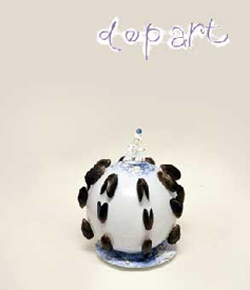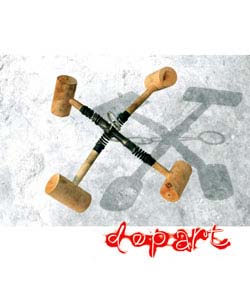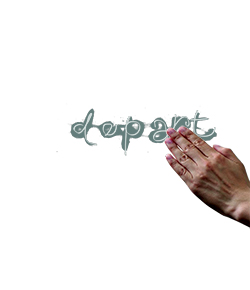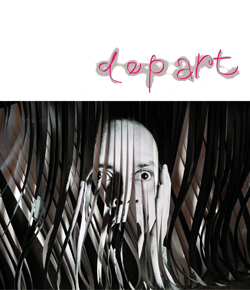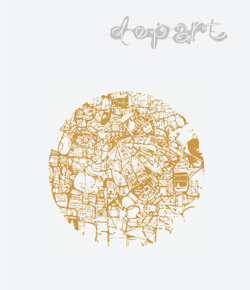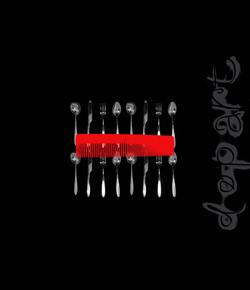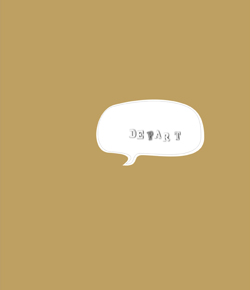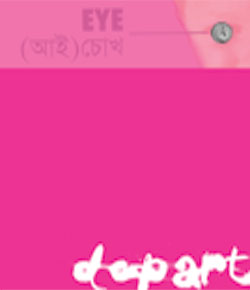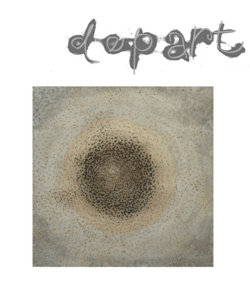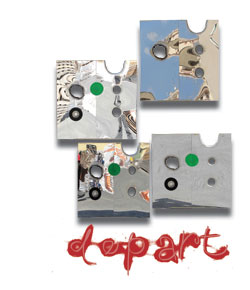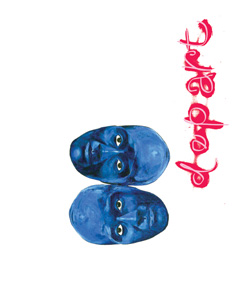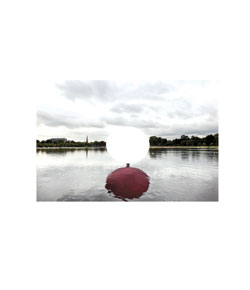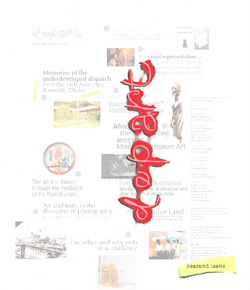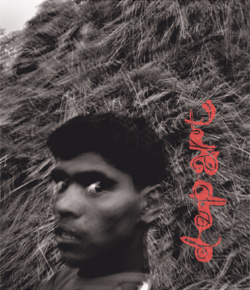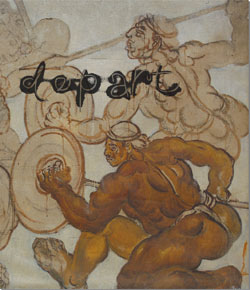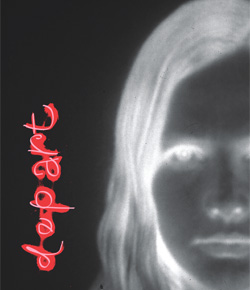art space
Crossing the line of demarcation
CrossOver, the India-Bangladesh workshop, served as a conceptually framed transient space for a group of artists from the two countries to register multivocality in the context of the greater convergence of the minds. It has yielded an exhibition that lasted from 23-29 December. SHAHMAN MOISHAN and MATIER RAFAEL of Depart attempt to unfold some of its material and immaterial aspects.


It is a given that an exhibition following a workshop will have its own practical limits in respect to the artistic as well as logistic scope and breadth; but the fact that it is the outcome of a workshop that has provided maximum stimulation to the participants while facilitating an intense interactive atmosphere for the artists to re-figure their stratagem, and also an opportunity to depart from set procedures and processes.CrossOver (Dhaka phase), a workshop organized by Depart, the English language art magazine based in Dhaka, which resulted from a joint curation between Indian curators Sushma K Bahl and Archana B Sapra and their Bangladeshi counterpart Mustafa Zaman, who is also editor of Depart, was a site to explore and also to regenerate some of the most pertinent aesthetic issues of our time.
To re-inscribe the Dhaka art scene with some interesting counterpoints, and to show at once how in a mature market climate Indian artists are operating, CrossOver, provided what we may call a glimpse into the art that is grounded in the 'here' and 'now' of our time.
Sushama Balh's curatorial statement defines CrossOver as a space where the interactions and interfacing between minds and artistic expressions would lead to crossfertilization. Mustafa's too was concerned with how individual crosses their own aesthetic limits to arrive at new points of departure – a process which impregnates the site of the workshop with the potential to work as a conduit for minds ready to issue forth interesting ideas and imagery. Though the discursive patterns that emerged from the statements and talks during the interactive sessions is as important as the artistic activities that went on during the workshop having continued from December 19 till 23rd of the same month – the five days of activities that saw production of art being dovetailed with formal interactive sessions as well as informal interactions, provided ample opportunities for the artists to be aware of how at this point of history they are being hounded by the development in both the fields of theory and practice. So the focal point was to find a way to retool oneself in an environment of interactivity which the workshop facilitated.
CrossOver
Jointly curated by Delhi-based curators Sushma K Bahl and Archana B Sapra and Dhaka-based artist and writer Mustafa Zaman, CrossOver is a site that has reconfigured the workshop space by staging interactivity and multivocality as an outcome of the interfacing between the participating artists' vision and the curatorial framework.
Supported by Depart, an English art quarterly from Dhaka, and Art Mall, one of India's largest art galleries, CrossOver is sequenced in two phases: one in Dhaka from 18 to 24 December 2011, and the other in Delhi from 17 to 22 January.

Crossover(s) – both the show and the workshop that preceded it – were efforts that sought 'to enhance the discourses that are already underway in the art scene of the region,' says Mustafa. The nuances that were missing in framing the new/emerging art as well as the position of the artists vis-à-vis those new languages and the social realities that are a part of it all, are something which Depart has been trying to address since its emergence in January 2010, and one can easily see that the workshop was an extension of that effort in the sense that the Bangladeshi participants were representing the very firmament that is brewing at present.
The 'now' and 'here' reflected on the artistic languages always come with some form of risk; it is primarily associated with how the artist issues forth his/her artistic production to inscribe it with some visual elements carrying evidentiary values. When translating present situations into artistic vocabulary, artists are often caught on the wrong foot: through the wholesale appropriation of the Western idioms some artists seem to want to forward a sense of contemporaneousness; the predicaments arising out of such forced alignment with the 'now' and 'here' effect the artistic processes and often stand at a variance from their own nature and proclivities. At CrossOver, it seems, negotiation has been the order of the day, and that too has been the outcome of the individual's willingness to examine how certain idioms can be interiorized to augment one's own creative horizon. And for some it was also to re-examine their own established language with the application of the new materials or stratagem to see how that plays out in their artistic experience and visions that the artists stand for.

From the Bangladeshi pool, artists such as Abdul Halim Chanchal, Monjur Ahmed and even Swarnali Rini to some extent, in their own individual ways, try and reconcile their personal vision with the current surge for a need to open up dialogues which have obvious social and political implications. Ronni Ahmmed and Rafiqul Shuvo, on the other hand, have chosen to unfurl a 'sacred' ground, both on their own terms. The concept of the sacred for these two artists is neither an upshot of the hagiographic models we are all familiar with, neither is it a virtual space the moderns once craved to construct while seeking to establish the autonomy of painting. Theirs has to do with the intention to radicalize the artistic space through methods that bring into play their own metaphysical interpretations of reality. This time around, Ronni seems more inclined to ditch the esoteric complexities that he is often associated with to foreground his tongue-in-cheek take on the popular forms of representation of cow, Kali etc.

From the sequined painting of mythic references by Ronni Ahmed to the post-materialist approach of Shuvo's black and white canvases, the Bangladeshi counterpart is more inclined to push the boundary rather than traverse the beaten paths.
High art's severity and temperateness has also been banished from many an Indian artists' work. Probably the ascent of Chinese contemporary art to the stature of a global phenomenon has impacted regions across Asia. If we are to contextualize the works of Farhad Hussain, Puja Bahri and Dileep Sharma, one possible perspective would be to view them in relation to the popular (both from within and outside the media) images that are being churned out in all consumer societies. Their work seems like an agreeable blend of contemporary techniques and individual creative processes where the difference between 'high' and 'low' art has collapsed as they voice the process of hybridization of the collective consciousness that has been underway for some time now. All three of them are meticulous in their effort to bring into view the details their subject matters entail, and both Farhad and Dileep tend to avoid artistic ploys that may render their visual proposition paradoxical.


The output of CrossOver is proof enough that the current global trends could not be set aside in favour of a purist local language of art in this era of global connectivity. In the majority of the arts produced at CrossOver, 'identity' has been negotiated in various personalized ways. If Ronni's was a way for him to re-enter Hindu cultural inheritance through extra-scriptural deities and symbols such as the cow and Kali; Abdus Salam's was through the release of a scathing critique using in-the-face elements drawn from Bangladeshi moviedom; and West Bengal based artist Farhad's is a kitschy representational technique where he enacts family drama which gives off an aura of intentional 'blandness' integral to images in communication materials.


We may come away with the feeling that the participants – both from India and Bangladesh – had their foot on their own turf while their art seems to be informed, to various degrees, by the global development in the last two decades. Influences that current trends exert on them acted as catalysts for the coupling of the two worlds – one represented by the development within one's own country and the other in the dominant trends currently sweeping the international terrain. The against-the-grain aesthetic of Abdul Halim Chanchal, Mohammad Wahiduzzaman, Ripon Saha, Rini and Rafiqul Shuvo seems to complement the surge of anti-aesthetic that had gripped the West since the 1990s. With their playful take on the politics of art in relation to how our perceptions are shaped and reshaped through channels of mass communications, Chanchal and Wahiduzzaman, both attempted to formulate a critique of how the world works.

However, at CrossOver, not only have the artists engaged themselves in social and political dialogues, but also with the procesal aspect of art-making that either has yielded aesthetically pleasing results, or has led to indeterminate ends. That 'process' itself is a driving force behind art when artists want to re-establish ties with the society, or to be in tangent with established social norms, has been variously demonstrated in this event. Artists such as Jagdish Chinthala, Bhagat Singh, Pragya Jain, representing India, and Monjur Ahmed, Wahiduzzaman, Anukul Mojumder and Ripon Saha, among the Bangladeshi participants, have proved, over the five-day span of CrossOver, that there is a route to be followed and acts to be engaged in to arrive at the desired results. Jagdish's process spreads beyond the acts of organizing his coloured paper constructions that reside somewhere between collage and relief work; and that this widely travelled artist picks up his tools – ranging from bus conductor's punch machines to the ones used for decoration, which the artist collects from across the world – bears down on the work he does within the studio space. Bhagat and Pragya, on the other hand, have processes that are not so interconnected with the happenings of external world, at least, not in the manner Jagdish prefers to demonstrate the threads of referentiality that finally leads to his otherwise abstract compositions. These two artists, inclined as they are to effect an eye beguiling scenography, draws from two divergent sources – Bhagat from popular art and Jain from contemporary design.
As for Anukul and Ripon, both are given to treatments that appear in sequences, and make visible their final imagery threading the phases and bringing them in alignment with their conceptual goals in ways that leave enough room for controlled accidents. If the former creates the aesthetic possibilities through performativity, the later shows a tendency to ideation and intellectualization. If Anukul's world seems to appear as the sum total of his intuited and existentially understood Whole, Ripon's is as fragmentary as that of a social commentator – as he fixes a critical gaze on the consumerist, positivist tendency of the current world order.
The concept of heterotopia, by which Foucault posits heterogeneity to a particular place at a particulate time, brings us closer to the idea of CrossOver seen as a conjunction of spatial-temporal realities for a group of artists from two neighbouring countries, who, for the first time, seized the opportunity to come together as a thinking, acting, and moving group of people ready to respond to all sorts of stimuli. Coursing through multiple spatial zones, some of their own making, and others, related to their respective geographical/cultural memories they bring into the designated site of the workshop, the participants are the ones who redefine, re-organize space, making both space and time yield to their desires and in turn create possibilities for exchanges and interactions.
Any space is a product of relations and is at once real and symbolic, and that we have 'doers' involved in 'doing' – this fact alone makes the space(s) and the bodies create a web through which to arrive at crosspollination. And this is what has been our point to which we would like to travel again and again. Such an act of repositioning vis-à-vis art and its context by adequately responding to the changing space-time axis, we thought would only be possible in the ad-hoc site which is a workshop. Therefore the yields of CrossOver can always be seen through this spatial and temporal lens.— Mustafa Zaman
co-curator, CrossOver
The workshop has seen Wahiduzzaman attempting to cross over to a relatively newer ground; his process seems to want to reconcile the two worlds – one of the psychic condition born out of the depredation and morbid goings on of our age and the other of the popular form of representation that allows him to navigate a wide topography to draw his elements and inspiration from.
Monjur's process, on the other hand, is dependent on how he interfaces the world of representation with the world he is witness to – which is seen as a playfield for the dictatorial political forces of our time that often make their appearances in the garb of peace and democracy.
Artist Gurdeep Singh stands at a distance from others by building on the process painting of the mid-twentieth century Euro-American abstraction. The vivid colours and busy composition come together to pay homage to colour field painting; though, at the same time, he seems to produce a surface density which, at once, addresses chaos and silence.
CrossOver is an Indo-Bangladesh artists' residency– an open platform for a creative interface between invited artists from the two neighbouring countries with strong cultural and historic ties. The curated project involves a core group of twelve artists, six from different parts of India and six from Bangladesh, who come together to share their ideas, practices and concepts around contemporary art in today's changing global scenario. CrossOver is a forum for divergent voices and aesthetics to be shared and appreciated, for the creative group to reflect on borderless terrain in this networked age with its under-currents and cross-currents – the world as here and now.
Planned in two distinct phases- a week-long residency in Phase I at Dhaka in December 2011, followed by another week's residency in phase II at New Delhi in mid January 2012, this private initiative is funded by two independent cultural organizations and individuals - K Anis Moquit, publisher of Depart in Dhaka and Ila and Naren Jain of Art House/Art Mall in Delhi. The project is co-curated by Archana Bahl Sapra and Sushma Bahl from India and by Mustafa Zaman from Bangladesh.
— Sushma K Bahl
Co-curator, CrossOver


Most of today's workshop space is an experiment in how the space-time matrix works out for the participating artists and how by introducing a conceptual frame it can be ensured that from within that matrix some new artistic productions will issue forth, ideas would generate occasioning a re-framing of art against the region's cultural-social landscape at large. CrossOver aimed to achieve just that but the curatorial framework that was a defining factor in the outcome of the event, clearly suggests a departure from the set rules of the game. As, here, not only the artists were given a free hand, but as an all encompassing framework, CrossOver accommodated demands for the most outrageous, extraneous materials, the stamp of which is clearly seen on the works produced by local artists. But the success of such a venture is to be decided by whether the creative processes informed by the spatio-temporal realities or circumstances could engender a break from the social/historical time using the force that is experimentality.
Translation – DEPART DESK











